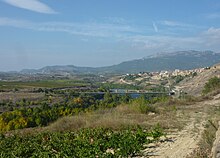La Rioja is an autonomous community in northern Spain, bordered by Basque Country, Navarre, Aragon and Castile and Leon. The region is popular because of its food and well known internationally thanks to the Rioja wine.
Cities
[edit]- 1 Logroño — The capital and hub of the region.
- 2 Briones — Small picturesque medieval town that hosts the Vivanco Museum of Wine Culture.
- 3 Enciso — The Paleontological Centre it's a good start to follow the dinosaur footprints spread across the southern part of La Rioja.
- 4 Ezcaray — Small scenic town home of the 2-Michelin starred restaurant El Portal del Echaurren and the ski area Valdezcaray.
- 5 Haro — Wine town that celebrates the Battle of the Wine every year on June 29.
- 6 San Millán de la Cogolla — The Yuso and Suso Monasteries were declared World Heritage Site in 1997, as the birthplace of the modern written and spoken Spanish language.
Other destinations
[edit]Obarenes-Sierra de Cantabria Natural Park outside Haro. Sierra Cebollera The Parque Natural Sierra Cebollera. Parts of the Camino de Santiago pass through the area and the scenery is spectacular.
Understand
[edit]The area was once occupied by pre-Roman Berones, Pellendones and Vascones. After partial recapture from the Muslims in the early 10th century, the region became part of the Kingdom of Pamplona. It was later incorporated into Castile after a century and a half of disputes. From the 18th century the Rioja region remained divided between the provinces of Burgos and Soria, until in 1833 the province of Logroño was created. The name of the province was changed to La Rioja in 1980 as a prelude to its constitution under a single provincial autonomous community in 1982. The name "Rioja" (from Río Oja) is first attested in 1099.
The region is well known for its wines, an integral part of Rioja's culture, listed under the brand Denominación de Origen Calizadas Rioja, the most highly regarded category in Spanish wine regulations.
Get in
[edit]- Logroño–Agoncillo Airport (RJL IATA)
- Rail journeys from Madrid, Zaragoza, Barcelona, Valladolid, Oviedo, Bilbao, La Coruña, Vigo are possible, since the Castejón-Miranda line crosses the region from east to west. The main railway station is that at Logroño.
- Road communications between La Rioja and neighbouring regions are primarily through the AP-68. The Autovía A-12 connects Pamplona to Logroño
Get around
[edit]See
[edit]

- Cathedral of Santa María, Calahorra
- Cathedral of Santo Domingo de la Calzada, Santo Domingo de la Calzada
- Co-cathedral of Santa María de la Redonda, Logroño
- Monastery of Nuestra Señora de Valvanera, Anguiano
- Monastery of Santa María, Cañas
- Monastery of Santa Maria la Real, Najera
- Yuso and Suso Monasteries, San Millán de la Cogolla, World Heritage Site
- Visit the UNESCO World Network of Biosphere Reserves in La Rioja
- Valles de JUbera, Leza, Cidacos y Alhama
Itineraries
[edit]- The Spanish Language Route[dead link]
- Way of St. James
Do
[edit]
- El Barranco Perdido, Enciso. Palaeontological park with swimming pool and activities related to the dinosaurs.
- Valdezcaray, Ezcaray. Ski resort with 22 kilometres of slopes and San Lorenzo as the highest peak with 2125 metres.
Eat
[edit]Drink
[edit]Rioja wine
[edit]Rioja wine is made from grapes grown in the La Rioja and Navarre, and the Basque province of Álava. About 90% of the cultivation is of red grapes, the remainder being white grapes. Rioja is subdivided into three zones: Rioja Alta, Rioja Oriental and Rioja Alavesa. Many wines have traditionally blended fruit from all three regions, though there is a slow growth in single-zone wines.
The traditional varieties authorized by the Regulating Council of the D.O.Ca. Rioja have been four red and three white:
- Red varieties: Tempranillo, Garnacha tinta, Mazuelo (also known as Cariñena) and Graciano.
- White varieties: Viura (also known as Macabeo), Malvasía and Garnacha blanca.
Since 2007, additional varieties have been permitted:
- Indigenous red varieties: Maturana tinta, (also called Maturana parda or Maturano)
- White varieties:
- Autochthonous varieties: Maturana blanca, Tempranillo blanco and Turruntés or Torrontés (not the same as the varieties named Torrontés cultivated in other parts of Spain and the rest of the world).
- Foreign varieties: Chardonnay, Sauvignon blanc and Verdejo.
Depending on the time the wine remains in the barrel it is classified as:
- Crianza:
- Red wines are aged at least one year in oak barrels before bottling, and at least two years in total.
- Whites and rosé wine are aged at least 6 months in oak barrels before bottling, and at least two years in total.
- Reserva:
- Red wines are aged at least one year in oak barrels before bottling, and at least three years in total.
- Whites and rosés: the same as for Crianza.
- Gran Reserva:
- Red wines are aged at least two years in oak barrels before bottling, and a further three years in the bottle.
- Whites and rosé wine are aged at least 6 months in oak barrels before bottling, and at least four years in total.


